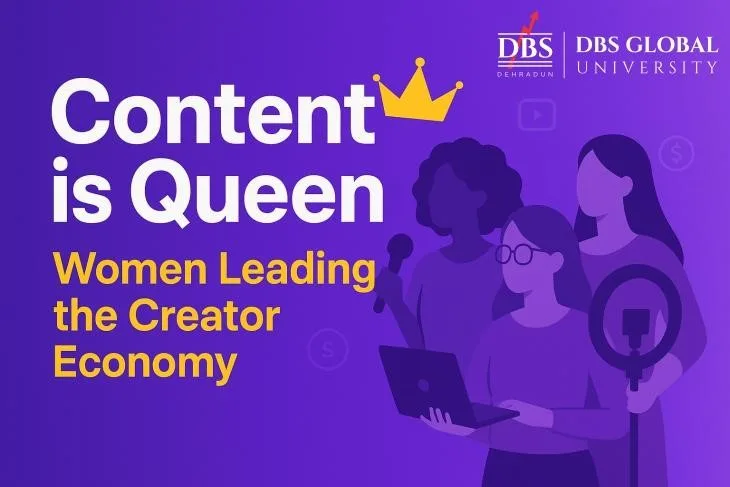
The Future is Female: Women Leading the $100 Billion Creator Economy
admin
- 0
The numbers back it up. Nearly two-thirds of content creators are women, and on platforms like Instagram and TikTok, they comprise the overwhelming majority. A beauty founder can sell out products in minutes during a livestream. A podcaster can sign a deal bigger than some Hollywood stars. What makes their influence so powerful is not just the reach; it is the personal connection that turns followers into fans and fans into customers.
But it is not all smooth sailing. For every headline-making success story, there are realities that are less glamorous: the pay gap, the constant pressure to stay relevant, the risks of depending on algorithms that change overnight. This is not only a story about opportunity, it is about resilience, strategy, and the fight for fairness in an industry that never switches off.
In this piece, we are going to look at the numbers, meet the women leading the charge, and unpack the trends shaping this new era. Because when content is queen, understanding the women who rule it is no longer optional; it is essential.
Data Deep Dive: Women’s Dominance, Earnings, and Disparities
The creator economy has gone from niche to global powerhouse. More than 50 million people around the world now call themselves content creators, and the industry is set to cross $100 billion in value by 2025. But look a little closer and the picture gets clearer: women are not just part of the movement, they are the ones steering it.
Representation
Across platforms, women are not just present, they are leading the way. Globally, they make up about 64 percent of creators, and in niches like beauty, lifestyle, wellness, and education, the numbers climb even higher. On Instagram and TikTok, nearly four out of five influencers are women, setting trends that shape everything from fashion choices to shopping habits. Even on YouTube, a space once dominated by men, women have built a strong ground and continue to expand their influence.
Earnings Reality
The picture changes when money enters the conversation. On average, male creators make nearly twice as much as female creators, about $69,900 a year, compared to $37,000. Only a tiny slice of creators, around 3 percent worldwide, earn more than $500,000 annually, and women are still underrepresented in that top tier. It is a sharp paradox: women lead in numbers but fall behind in pay.
Regional Perspective
Take Africa as an example. Women make up 77 percent of monetizing influencers, powering a digital economy worth $3.08 billion in 2023 and projected to hit $17.84 billion by 2030. But the funding gap is massive. In 2019, Western creators pulled in $800 million in platform and investor support, while African creators shared just $22 million. The imbalance is clear: women may be leading the movement, but recognition and capital are not keeping pace.
Unleashing Creativity: How Women Monetize Smarter
The first wave of the creator economy was all about going viral. The second wave, where women are taking the lead, is about building something that lasts. Women creators have figured out how to turn influence into income by thinking beyond likes and views, and by treating their platforms like real businesses.
Multi-stream Revenue Models
Women creators are diversifying the way they earn. Beyond ad revenue, many are building income streams through online courses, paid memberships, licensing deals, and their own product lines. The result is powerful: communities that are not just followers, but loyal customers. It is less about chasing quick viral hits and more about building steady, recurring value.
Brand Partnerships Done Right
Almost 80 percent of creators say brand deals and affiliate marketing are their main source of income. What sets women apart is how they approach these partnerships. Instead of pushing polished ads, they weave products naturally into their storytelling, showing how a brand fits into everyday life. The result is powerful: trust becomes the real currency, not just reach.
Platforms Designed for Women
Platforms like LTK (LikeToKnowIt) show how big this shift really is. LTK connects influencers with retailers and has already created more than 400 influencer millionaires, many of them women. By turning shoppable content into full businesses, these women prove that this is not just side income, it is full-scale entrepreneurship.
The Trust Factor
What truly sets women apart is their ability to build loyal communities instead of passive audiences. One genuine recommendation can spark a sell-out, especially in beauty, fashion, and wellness. This trust-first approach is the reason their influence converts so powerfully into real sales.
Spotlight: Women Trailblazers & Tastemakers
Behind the numbers are the women who are redefining what it means to be a creator. They are not just building personal brands, they are building full-fledged empires.
- ●Trinny Woodall: Transformed her online following into a digital-first beauty empire, earning more than £70 million.
- ●Alex Cooper: Landed a $60 million Spotify deal for her podcast, “Call Her Daddy,” and now runs a media network.
- ●Alix Earle: A single Instagram Story can earn her $450,000, proving the power of Gen Z authenticity.
- ●Chiara Ferragni: Went from fashion blogger to running a company valued at more than $40 million.
- ●Sara Kehaulani Goo: Named President of The Washington Post’s Creator Network in 2025, she is pioneering the fusion of traditional journalism with creator-driven storytelling.
- ●Prajakta Koli: India’s most prominent digital storyteller, who has used her platform for social change.
- ●African Women Creators: Across Africa, women make up 77 percent of monetizing influencers, yet they receive a fraction of global funding.
Challenges & Real Talk
The creator economy sparkles on the surface, but behind that glow, there are shadows that rarely make the headlines. For women, success often comes with hurdles that demand resilience, reinvention, and a thick skin.
- ●The Pay Gap: Male creators earn nearly double what female creators do, despite women driving higher engagement.
- ●Visibility vs. Burnout: The pressure to post constantly to stay relevant often leads to mental health challenges.
- ●Funding and Infrastructure Gaps: In places like Africa and South Asia, women make up the majority of creators, yet they struggle to access capital.
- ●Platform Volatility: Careers are unstable when they depend on algorithms that can change overnight.
- ●Social Scrutiny: Women face harsher online criticism, double standards, and constant harassment.
Future Forecast & Strategic Moves
The creator economy is no longer a side hustle it is becoming the next great industry, rivaling traditional entertainment and advertising. For women, the future holds both massive opportunity and critical inflection points.
A Market Set to Explode
Industry projections suggest the creator economy will surpass $100 billion globally by 2025, outpacing the growth of legacy media. Subscriptions, direct commerce, and even blockchain-based ownership models are opening new ways to earn without relying solely on brand sponsorships.
The Next Wave of Monetization
Women are likely to lead in emerging income streams such as:
- ●Community-driven platforms (exclusive clubs, Patreon-style memberships)
- ●Education and expertise (courses, coaching, masterclasses)
- ●Product ecosystems (from beauty lines to digital tools)
- ●AI-assisted creation (automation and personalization at scale)
What Women Creators Can Do
- ●Diversify early: Dependence on one platform or one revenue stream is a risk women thriving in this space are spreading their influence across multiple channels.
- ●Leverage trust: Audiences already see women creators as more authentic; translating that into products and services will be key.
- ●Collaborate, not compete: Cross-creator partnerships can reduce burnout and open doors to new audiences.
What Brands and Platforms Must Do
- ●Pay fairly: Equal work deserves equal compensation; pay transparency is overdue.
- ●Invest in underrepresented markets: Africa, South Asia, and Latin America hold enormous potential if women there receive capital and infrastructure support.
- ●Design for sustainability: Platforms must rethink algorithms and monetization tools to reward depth of engagement, not just raw virality.
Conclusion
The phrase “content is king” once captured the internet’s early gold rush. Today, it feels outdated. Content is queen, and women are the ones wearing the crown. From podcast empires to beauty conglomerates, from grassroots communities to billion-dollar platforms, women are not only driving the creator economy, they are redefining what success looks like in it.
Yes, the journey is not without challenges; pay gaps, burnout, platform volatility, and unequal access to capital remain very real. But if history has shown us anything, it is that women have turned barriers into blueprints for innovation. They are building sustainable businesses where authenticity is the brand, community is the product, and trust is the currency.
Algorithms or follower will not measure the future of the creator economy counts alone, the ecosystems will measure it women create, the industries they disrupt, and the generations they inspire.
FAQs: The Future is Female: Women in the Creator Economy
Q1. Why are women leading the creator economy today?
Ans. Women lead because they excel at building authentic, trust-based communities that drive engagement and brand loyalty, turning creativity into sustainable businesses.
Q2. What challenges do women face in the creator economy?
Ans. Despite their dominance, women still encounter pay gaps, funding barriers, algorithmic volatility, and mental health pressures due to constant visibility demands.
Q3. How are women creators monetizing their platforms effectively?
Ans. Women diversify revenue streams beyond ad deals through online courses, memberships, product lines, and brand partnerships built on trust.
Q4. Which industries see the strongest female presence in the creator space?
Ans. Beauty, fashion, lifestyle, education, and wellness are the leading sectors where women creators hold majority influence and economic power.
Q5. How does DBS Global University prepare students for the digital creator economy?
Ans. DBS Global University empowers future creators through programs in Digital Marketing, Media Studies, and Business Management, equipping students with skills in branding, storytelling, and digital entrepreneurship.
The crown is not waiting to be claimed. It is already in the hands of the women who have built this economy, shaped its culture, and proven that influence, when paired with vision, is nothing short of transformational.


